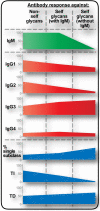Neurological disorders-associated anti-glycosphingolipid IgG-antibodies display differentially restricted IgG subclass distribution
- PMID: 32753699
- PMCID: PMC7403582
- DOI: 10.1038/s41598-020-70063-5
Neurological disorders-associated anti-glycosphingolipid IgG-antibodies display differentially restricted IgG subclass distribution
Abstract
Antibodies against several self-glycans on glycosphingolipids are frequently detected in different neurological disorders. Their pathogenic role is profusely documented, but the keys for their origin remain elusive. Additionally, antibodies recognizing non-self glycans appear in normal human serum during immune response to bacteria. Using HPTLC-immunostaining we aimed to characterize IgM and IgG subclass antibody responses against glycosphingolipids carrying self glycans (GM1/GM2/GM3/GD1a/GD1b/GD3/GT1b/GQ1b) and non-self glycans (Forssman/GA1/"A" blood group/Nt7) in sera from 27 randomly selected neurological disorder patients presenting IgG reactivity towards any of these antigens. Presence of IgG2 (p = 0.0001) and IgG1 (p = 0.0078) was more frequent for IgG antibodies against non-self glycans, along with less restricted antibody response (two or more simultaneous IgG subclasses). Contrariwise, IgG subclass distribution against self glycans showed clear dominance for IgG3 presence (p = 0.0017) and more restricted IgG-subclass distributions (i.e. a single IgG subclass, p = 0.0133). Interestingly, anti-self glycan IgG antibodies with simultaneous IgM presence had higher proportion of IgG2 (p = 0.0295). IgG subclass frequencies were skewed towards IgG1 (p = 0.0266) for "anti-self glycan A" subgroup (GM2/GM1/GD1b) and to IgG3 (p = 0.0007) for "anti-self glycan B" subgroup (GM3/GD1a/GD3/GT1b/GQ1b). Variations in players and/or antigenic presentation pathways supporting isotype (M-G) and IgG-subclass pattern differences in the humoral immune response against glycosphingolipids carrying non-self versus self-glycans are discussed.
Conflict of interest statement
The authors declare no competing interests.
Figures






References
-
- Huflejt ME, et al. Anti-carbohydrate antibodies of normal sera: Findings, surprises and challenges. Mol. Immunol. 2009;46:3037–3049. - PubMed
-
- Schnaar, R. L., Suzuki, A. & Stanley, P. Glycosphingolipids. Essentials of Glycobiology (Cold Spring Harbor Laboratory Press, 2009).
-
- McVey J, et al. Anti-A and anti-B titers in donor plasma, plasma pools, and immunoglobulin final products. Transfusion. 2015;55:S98–S104. - PubMed
-
- Springer GF. Blood-group and Forssman antigenic determinants shared between microbes and mammalian cells (Part 1 of 3) Progress Allergy. 1971;15:9–29. - PubMed
Publication types
MeSH terms
Substances
LinkOut - more resources
Full Text Sources
Medical

